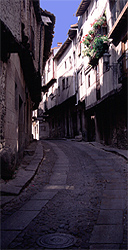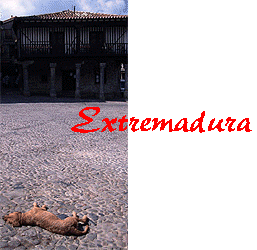






Extremadura
Perhaps the least visited and least populous region of Spain. Austere homeland
The monastry at Guadalupe,
The old walled city of Cacares
Extremadura is most easily seen by a car tour between the paradors of the region, public transport being fairly sparse and the roads quiet. Birdwatching for eagles and vultures along the road can be rewarding.
Frite is
lamb cooked in paprika.
Migas
is fried breadcrumbs.
Morros
is the pork fat next to the skin in tomato sauce. Served hot it was delicious
if not health food!
Hornazo
is a bread crust pie filled with various types of pork.![]()
Cachuela
Extremeña, a coarse cut spicy pate.
Birdwatching in Extremadura
CheeseWineSpanish cookery booksCookery reference books
Walking in Spain | Walking in Britain | Spanish photos | Spanish pronunciation & general guidebooks | Andalucia | Asturias | Basque Country | Canary Islands | Castile
Catalonia & Balearics | Extremadura | Galicia | Navarre | Valencia | Tapas | Glossary | Books